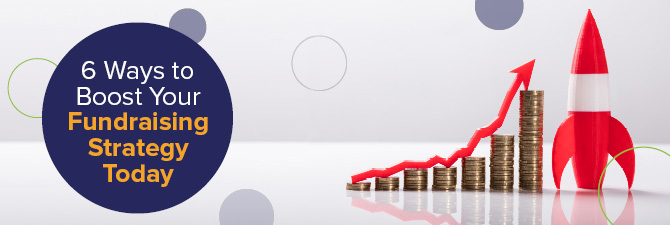-
Software
Compliance Software
Oversee licenses, track renewals, access documents, and more from a single interface.
Software Overview -
Services
Compliance Services
Full service compliance solutions for organizations throughout their entire lifecycles.
Services Overview -
Industries
-
Partner
- Information Center
6 Ways to Boost Your Fundraising Strategy Today

Fundraising can be difficult in the best of times. Now, during an economic downturn and a national pandemic, it’s become even more difficult. At the beginning of 2020, the fundraising trends showed only positive prospects for nonprofits. Now that we’re many months into the pandemic, your organization should begin thinking about boosting your fundraising strategy for the long-term.
In order to boost your fundraising strategy, you’ll need to carefully review the nonprofit strategic guide that you put together in the beginning of the year and reevaluate the various fundraising projects it contains. Specifically, you should focus on how you can rework that plan to focus on specific short-term wins and long-term strategies.
Your short-term wins are those that will help sustain your organization through the remainder of the COVID-19 pandemic. Your long-term strategic plans are designed to help maintain stability for your organization after the chaos from the virus ends.
With this in mind, let’s dive into both six of the strategies that you can use to establish short-term wins and achieve long-term goals.

Short-Term Wins
Restrategize Your Budget
Your nonprofit’s budget should be frequently referenced by your organization’s team. Like your strategic plan, it should be coffee-stained and maybe have a rip or two around the edges due to being pulled out and regarded so frequently (digitally, it should be one of your most viewed files).
Now, because your external circumstances have changed so drastically, you’ve probably adjusted both documents without even realizing it. For example, when the pandemic first began, did you:
- Adjust the major gift amount you requested from supporters to reflect newfound economic hardship? This changes the expected revenue referenced on your organization’s budget.
- Did you cancel a fundraising event? Or did you pivot to an online event and invest in new fundraising tech to do so? Canceling events also changed your anticipated budgeted revenue, and investing in new tech changed the anticipated expenses.
When you reanalyze your budget and make appropriate changes, don’t forget that these changes need to maintain all of the necessary components for your budget to remain compliant. Then, get the changes approved by the board.
Keep in mind that your organization should adjust both the expenses and your anticipated revenue in your budget as you plan for the remaining suggestions throughout this article.
Make a Wish List
While unemployment rates have decreased slightly from March, they’re still at an all-time high for individuals. This means that there is less cash available for individuals to contribute to the organizations they support.
However, you’ll find that your supporters still want to make an impact on philanthropic missions and to help the organizations they love to achieve goals. Therefore, one important way to encourage their continued support is to show them the direct impact that they can have on your cause. Wish lists are a great way to show this impact.
For example, consider an organization that works with disabled individuals, providing community and residency. Instead of asking for funding, they put together a registry so that supporters can purchase household items that can be used at the residence.
In this example, even supporters who are unable to make a large contribution right now may choose to purchase a less expensive item on the registry wish list. They know exactly how their contribution will help the community because they’re purchasing an item rather than donating a lump-sum of money.
If your nonprofit chooses to create a wish list, be sure to put items covering a wide price range. This will allow supporters to contribute at their own personal comfort level while making an impact on your mission.
Host Virtual Events
It’s been around five months since individuals have started working from home and limiting their contact with others in public. Understandably, some supporters may be going a somewhat stir crazy in their homes.
Virtual fundraising events are beneficial for both your organization and to help entertain your home-bound supporters.
Consider the entertaining events that your organization usually hosts. Is there a way to pivot these events to the virtual sphere? According to this guide, many of the planning elements for a virtual event are similar for in-person events. You’ll still need a planning team, awesome marketing materials, and sponsors. However, you’ll also need to consider new engagement strategies and test-run online software before the event begins.
Here are some of our favorite virtual event ideas that we’d recommend for nonprofits:
- Walk-through of headquarters
- Online workshops
- Virtual exercise classes
- Online conference
- Craft courses
- Virtual game nights
Remember that whether you’re hosting an event to steward your supporters or to recruit new donors, there are multiple ways to raise money throughout virtual events. Consider how you can leverage registration fees, peer-to-peer fundraising campaigns, and merchandise sales to raise additional funds during these events.
Never Assume
One of the most important things to remember while raising money during COVID-19 is that everyone has different circumstances. You shouldn’t assume that everyone is able to give to your nonprofit, but you also shouldn’t assume that they can’t give.
This is where many fundraisers ran into some trouble. They completely halted their fundraising processes when the pandemic first began, assuming that supporters would be unable or unwilling to contribute (or assuming that it would be rude to ask).
Many supporters still want to contribute during these tough times. Don’t assume their ability or affinity to give without first asking the question.
You should, however, reframe the way that you ask for contributions. Consider the following strategies to make sure you’re being sensitive to your donor prospects while asking for funding:
- First, ask them how they’re doing. Make sure your supporters know that their well-being is your first priority. Asking how they’re doing may also provide some insight as to how to proceed with the conversation.
- Provide options for contributions. When you ask supporters to give to your nonprofit, provide them a few different ways that they can contribute to the organization. For instance, give them options to give financially, to participate in advocacy campaigns, or to give in-kind.
- Find ways to maximize donations. Your nonprofit’s supporters are more likely to contribute to your organization if they know that their donation will go further. Double the Donation’s statistics show that donors are 84% more likely to give when they know their contribution will be matched by their employer. Look for these opportunities to encourage more supporters to give.
You’ll never know what supporters are able to contribute if you don’t ask them. So ask them! Frame the ask well, but the important thing is to ask.

Long-Term Strategies
Keep Working Capital Campaigns
Bloomerang’s capital campaign guide defines a capital campaign as an intense effort on the part of a nonprofit to raise significant funds in a specific period of time.

The “specific period of time” referenced in this definition generally spans over a period of a few years. Although it might not be the right time to start a capital campaign, if you’re in the middle of one, you should make sure to keep working on it.
Your next steps for the campaign during the pandemic may depend on where in the capital campaign process you’re currently in. Consider the following stages:
- Planning process. If you’re still in the planning process for your capital campaign, keep on planning! You may decide to postpone the start date for the campaign until after the pandemic ends, but you can never be too prepared, so plan away.
- Quiet stage. This is the stage when your organization collects major contributions to make up the bulk of the funding for your campaign. Be sure to talk to your major contributors to see how they feel about moving forward with your campaign. After open communication, you may choose to postpone this stage of the campaign. If you do, be sure to keep these vital donors in the loop and maintain an open line of conversation.
- Public stage. If you’re in the public stage of your nonprofit’s capital campaign, you’re collecting smaller contributions to round out the end of the campaign. At this point, you should have an open discussion about options with your board members. What’s the current trajectory of the campaign? Will you hit your target? Can your project be pushed back? If it can’t be, what alternatives can you employ to your fundraising campaign to reach the goal?
Capital campaigns may be tricky when external circumstances also present challenges. The most important thing is that you maintain open lines of communication and carefully consider your options before making any decisions regarding fundraising.
Focus on Donor Retention
The pandemic won’t last forever. Right now, it may seem like it will, but the chaos will end eventually. To support your long-term fundraising strategies, your organization should focus on retaining donors after the pandemic ends. You can do this by stewarding your supporters and engaging them whether they’re able to give right now or not.
Retaining donors is far more cost-effective than acquiring new donors. By increasing donor retention by just 10%, the average nonprofit organization can increase its fundraising revenue by hundreds of thousands of dollars.
To increase your retention rate, your nonprofit should be sure to continue personalizing communications with supporters using relevant data from your donor database to maintain a sense of connectivity with them. Also, find additional engagement opportunities that they can participate in. For example, consider the following opportunities:
- Virtual stewardship events like craft nights and happy hours
- Regular updates about your mission and your organization
- Virtual volunteer opportunities to contribute time rather than money
- Sending notes of appreciation for long-term supporters to show your thanks
Donor retention is an important metric to watch during the best of times in nonprofit fundraising. Now, it’s even more important.
The last thing you want is, after the pandemic, for your supporters to believe you’ve forgotten about them or to think you only contact them when you need funding. Instead, by keeping communications strong no matter the external circumstances, you’ll find that your retention rate increases post-pandemic conditions. Your nonprofit will get back on your feet before you know it.
Fundraising is a hard job. During a pandemic, it becomes even more challenging. However, by reading about the various strategies and options that your nonprofit has to raise funds during hard times, you’ll find that it’s easier to keep your doors open during the pandemic. Plus, implementing long-term strategies will help keep your nonprofit secure in funding down the line. Good luck!
Harbor Compliance does not provide tax, financial, or legal advice. Use of our services does not create an attorney-client relationship. Harbor Compliance is not acting as your attorney and does not review information you provide to us for legal accuracy or sufficiency.

Jay Love is Co-Founder and current Chief Relationship Officer at Bloomerang.
He has served this sector for 33 years and is considered the most well-known senior statesman whose advice is sought constantly. Prior to Bloomerang, he was the CEO and Co-Founder of eTapestry for 11 years, which at the time was the leading SaaS technology company serving the charity sector. Jay and his team grew the company to more than 10,000 nonprofit clients, charting a decade of record growth.
Jay is a graduate of Butler University with a B.S. in Business Administration. Over the years, he has given more than 2,500 speeches around the world for the charity sector and is often the voice of new technology for fundraisers.





